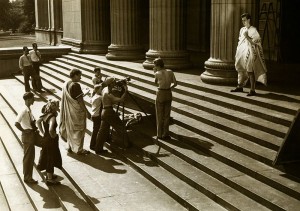The inclusive model of journalism that is evolving online will demand more editors than the media world has ever seen. In effect, all journalists will become editors. They will learn to gather first-person accounts and combine them with expert insights to create a tapestry of information. They may then be called upon to tend and update those stories for years. Journalists will be at the vortex of an information swirl, and their ability to sort through and harmonize information from many sources will be their principal value.
These new rules will demand a different set of skills than the ones historically taught by journalism schools and demanded by professional editors. As we have noted in earlier essays, the role of the reporter will become less prominent in the value chain. In the past, reporters were taught to gather and sift through large amounts of information, discarding selectively as time and space limitations dictated. In the future, space limitations will be irrelevant. Every bit of information can be captured and archived forever. Time demands will both shrink and expand.
Deadlines Compress, but Stories Never Die
They’ll shrink because deadlines will be constant and unrelenting. Journalists will be under pressure to publish news in near real-time. This will demand new aggregation and organization skills. A single journalist will no longer be the funnel — or bottleneck, depending on how you view it — for news events. Ordinary citizens will deliver important news accounts as they happen. A journalist’s competitors will no longer be a handful of regional print and broadcast outlets but an army of interested stakeholders who, in many cases, are more knowledgeable about the topic than the reporter.
It will be futile for a news organization to compete with this kind of citizen firepower. The only rational strategy is to co-opt it. That means reporters must develop relationships with people closest to the story, create the means to capture their observations and perspectives and deliver them quickly. Reporters will become, in effect, editors supervising a loosely formed team of interested stringers.
On the back end, time frames will lengthen considerably as news stories become archives. The Wikipedia model is perhaps the best illustration of this. On Wikipedia, stories begin as a “stub” and grow to sometimes epic proportions. Journalists will no longer write just “the first draft of history,” but will help to shape an archival account of considerably more long-term value. In some cases, a journalist’s career may become tied to a single story that he or she tends and enriches over time.
Promise and Problems
This model has great potential but also great challenge. The loss of trust is a huge issue. While not everyone trusts the news media, they can at least be reasonably certain that professional editors are working in their best interest. The inclusive journalism model has no such guarantees. Anyone can publish anything he or she wishes online, so editors will be needed to arbitrate conflicting claims.
This will certainly require old-fashioned reporting techniques. When the facts can’t be discerned from field reports, it will still be up to the professional journalist to get on the phone and verify them. Readers will come to trust these professional truth-sayers, whether they be individual journalists or media institutions. That’s an important point. In the future, readers may make little distinction between The New York Times and an independent journalist as long as they believe they can trust the source. As Matt Drudge demonstrated a decade ago, trusted brands can emerge without the blessing of media institutions.
Disclosure Trumps Verification
News will increasingly be published without the rigorous fact-checking that information consumers have come to expect. This is a controversial issue, but all trends point to accuracy becoming less vital as a criteria for publication than it is today.
The reason is that published information is no longer archival. Online reports can be changed at any time, which means that the impact of incorrect information is greatly diminished. Today, publication is no longer an end but a beginning. Disclosure will become more important than confirmation. Readers will come to accept that not all the facts are confirmed as long as those shortcomings are disclosed.
The fit and finish that has been characteristic of print publications will diminish in importance. While this is a difficult idea for many editors to accept, the reality is that online information consumers are more tolerant of typos, grammatical errors and structural inconsistency than print readers (this blog is perhaps a good example!). While some media outlets will continue to take pride in delivering high quality finished product, many readers will accept a trade-off between perfection and timeliness. Top editors are already coming to accept this. Faced with staff cuts and the need to do more with less, major newspapers are discovering that they no longer need a dozen editors to touch every front-page story.
In short, journalists will need to significantly broaden their range of skills.. The journalist of the future will be a resourceful, online-savvy and relationship-driven aggregator of information with the ability to apply reportorial shoe-leather where needed. Deadlines will contract on the front end, but stories may live for years in a continually updated archive. The journalist will become part reporter, part editor and part librarian, playing a pivotal role in framing the stream of events and opinion for an audience that demands context.
Other posts in this series:
The Future of Journalism, Part I
The Future of Journalism, Part II






